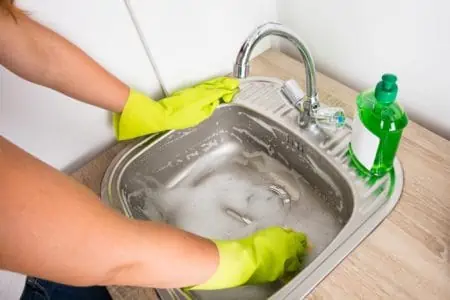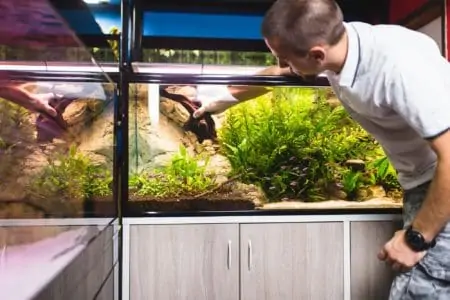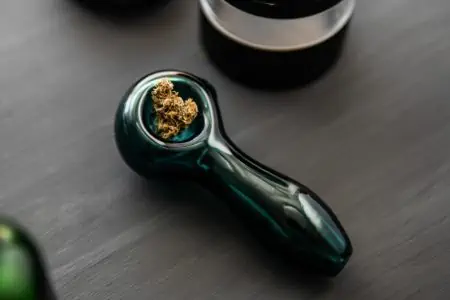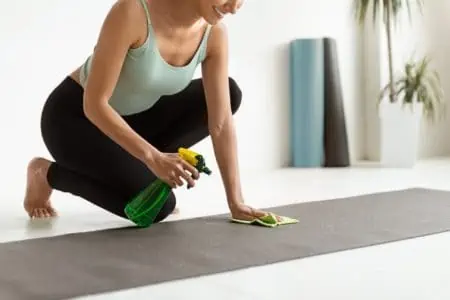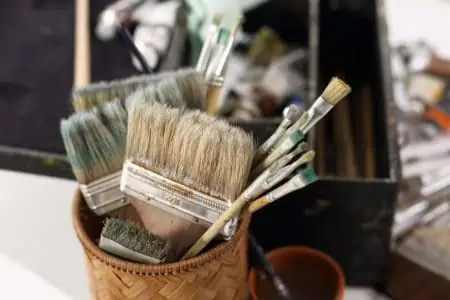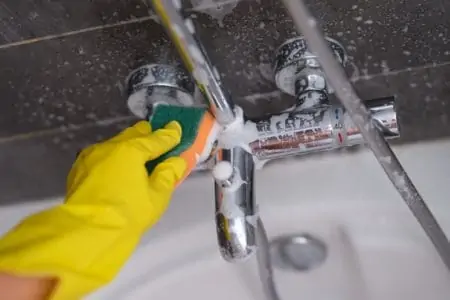Plexiglass is used for so many things in our home. It’s important to know how to clean it.
For instance, plexiglass is commonly used for windows, skylights, boat windshields, glazing, storm fixtures, video screens, dividers, picture frames, shelving, countertops, and much more.
We’ll show you how to clean and disinfect plexiglass without scratching it or leaving behind a foggy haze. Consider this your ultimate guide to cleaning plexiglass.
Key Takeaways
- Clean plexiglass without scratching it by blowing off dust and debris, then use a homemade cleaner with one teaspoon of dish soap and one quart of water.
- Use a soft, lint-free microfiber cloth to wipe the plexiglass without scratching it.
- Disinfect plexiglass with an approved alcohol-based cleaner, avoiding high alcohol content that can crack the surface.
- Avoid using ammonia, abrasive cleaners, heat, scrubbing, or solvent cleaners when cleaning plexiglass.
Homemade Plexiglass Cleaner
We love making our own DIY cleaners. We have a great homemade plexiglass cleaner recipe that you can use across all plexiglass. It’s safe, non-toxic, and will ensure that you don’t scratch your plexiglass.
In a spray bottle, mix together:
- One teaspoon of dish soap
- One quart (950ml) of water
Shake well, and you’re ready to go! It’s that easy.
How to Clean Plexiglass Without Scratching It
We’ll show you how to properly clean Plexiglass using your DIY cleaner. This method will include removing dust and debris first, then cleaning with your cleaner without causing any scratches. You can use this method for any Plexiglass surface.
- Time: 20 minutes
- Difficulty: Easy
What You’ll Need
- Hair dryer
- Homemade plexiglass cleaner
- Lint-free microfiber cloth
1. Blow Off Dust
The first thing we must do is remove dirt and dust. You might think your usual duster would come in handy here, but you’re wrong. When you come into direct contact with the Plexiglass to remove dust, you can actually grind the dust and debris into the Plexiglass and cause scratches.
Instead, you will need to use air to remove dust. You can use your own breath by blowing onto the Plexiglass, but your lungs will soon get tired!
Instead, we recommend using a hair dryer on the coolest and lowest setting. Hold the hair dryer at a 45-degree angle a few inches away from the glass and blow from side to side, starting at the top and working your way down to the bottom.
You don’t want to heat the Plexiglass, so be sure you’re using cool air and holding the hair dryer away from the Plexiglass.
2. Apply Cleaner
Spray your homemade Plexiglass cleaner over the Plexiglass. Work in small sections if you have a large area to cover.
3. Wipe
Use a soft, lint-free microfiber cloth to wipe the Plexiglass gently, only on areas where you’ve applied cleaner. Don’t wipe dry areas. Continue this process, repeating in small sections until you’ve cleaned the entire Plexiglass.
How to Disinfect Plexiglass
To stop the spread of germs, it’s vital to disinfect Plexiglass, especially in communal spaces. For this, you’ll need to find a cleaner that’s safe to use on plexiglass or acrylic. There aren’t many available that contains a little alcohol, which you need for sanitization. One option is the Sprayway wipes. Another option is to dilute water with isopropyl alcohol in a 10:1 ratio.
- Time: 30 minutes
- Difficulty: Easy
Warning
Too much alcohol can crack Plexiglass, so test in an inconspicuous spot first.
What You’ll Need
- Plexiglass-approved alcohol-based wipes or isopropyl alcohol
- Spray bottle (optional)
- Water (optional)
- Disposable gloves
- Two lint-free microfiber cloths
1. Clean Plexiglass
Start by cleaning your Plexiglass using the three-step method from above.
2. Prepare Disinfectant
Put on your disposable gloves. This will protect your hands from both the germs and the alcohol solution.
If you’re making your own solution, mix a 1:10 ratio of isopropyl alcohol and water in a spray bottle. Shake to combine.
If you’re using wipes, get them out now while wearing your disposable gloves.
3. Apply Cleaner to the Glass
If you’re using a spray, gently mist it over the plexiglass.
If you’re using wipes, gently wipe them over the surface in small gentle circular motions. Follow the manufacturer’s advice for any additional tips.
4. Wipe Plexiglass
Using your lint-free microfiber cloth, gently wipe down the Plexiglass. If you used your homemade cleaner, make sure to remove all of the moisture.
5. Dry the Plexiglass
Using a dry microfiber cloth, wipe the Plexiglass again. If you leave any alcohol residue on the Plexiglass, it can stiffen or crack.
What to Avoid When Cleaning Plexiglass
Don’t use the following to clean Plexiglass:
- Ammonia
- Abrasive cleaners
- Aromatic or scented cleaners
- Heat
- Scrubbing or rubbing
- Solvent cleaners (such as acetone or polish)
- Cleaners with high alcohol content
- Glass cleaners (such as Windex)
How to Clean Plexiglass Scratches
Hopefully, you’ve avoided scratches on your Plexiglass, but if not, we can share some instructions for removing micro-scratches using four methods: scraping, sanding, buffing, or flame-polishing.
You don’t have to do all of them, but if you are doing multiple, you must do them in order. For instance, if you want to flame-polish, you must first scrape, sand and buff.
- Time: 45-60 minutes
- Difficulty: Expert
What You’ll Need
- Razor blade
- Sandpaper (between 220 and 800 grit, depending on how deep the scratches are)
- Face mask
- Clamps
- Cloth buffing wheel
- Drill
- Polishing wax
- Dry microfiber cloth
- Propane or acetylene burner with adjustable end
By Scraping
- Scrape: With your razor blade, run the blade from side to side to remove grime. Keep the blade at an angle of around 10 degrees to prevent damaging the Plexiglass.
- Slide: If you have jagged or uneven edges, slide over them with the blade. Shave off small pieces slowly until the edge is even.
By Sanding
- Choose your sandpaper: For deep scratches, start with a grit between 220 and 320. Move up to 600 or 800 as you go, if necessary.
- Wear your mask: A mask will help you avoid dust inhalation.
- Prepare your sander: You can do this step-by-step, but you can also use a sander if you prefer. If you do choose to use a sander, don’t press the sander into the glass. Always be gentle and keep the sander moving to avoid any heat building up.
- Sand: Using your hand or a sander, sand the Plexiglass as you could with a piece of wood, continuing until the surface is smoother.
By Buffing
- Secure Plexiglass: Secure your Plexiglass sheet to a base using clamps. You don’t want it to slip.
- Clamp your wheel to your drill: You can get a cloth buffing wheel for standard drills. Attach that now.
- Apply polishing wax: Apply fresh polishing wax to your cloth buffing wheel. If your buffing wheel has old wax on it, you will need to clean that off first.
- Buff: Turn on your drill and move the wheel across the edge of the Plexiglass using very light, even pressure. Continue doing this to buff the entire piece of Plexiglass.
- Wipe away wax: Wipe off excess wax with a dry microfiber cloth.
Did You Know
How fast the buffing wheels moves is determined by the size of the wheel. If the wheel is larger, set a low speed. If the wheel is smaller, use a higher speed.
By Flame-Polishing
- Prepare: Put the Plexiglass on a fireproof surface.
- Light and adjust: Light your burner and adjust the flame so that you have a pencil flame — this looks like a tapered shape around the size of a pencil.
- Flame-polish: Aim the flame to the edge of the Plexiglass and bring the burner along the edge in a swift gentle movement. Make sure that the flame doesn’t directly touch the Plexiglass. The Plexiglass will briefly melt and reset into a smooth surface. Continue until you’re satisfied.
Cleaning Plexiglass With Toothpaste
There’s a quick Plexiglass cleaning hack that you may come across. This is to use toothpaste. This alternative tip is handy in a jiff, but make sure you use toothpaste without abrasive materials. The toothpaste can polish your Plexiglass and even out scratches.
Once you’ve blown off dust and debris, place a 2-inch strip of toothpaste on a soft, lint-free, microfiber cloth. Apply the toothpaste to the Plexiglass in small circular motions.
Wipe the toothpaste off of the Plexiglass with a separate cloth. Then dampen another cloth to clean the area. Buff the Plexiglass one more time with a separate dry cloth to avoid a cloudy residue.
FAQs
Plexiglass Cleaning Summary
To conclude, it’s clear that Plexiglass isn’t the easiest to clean, nor is it the most scratch-resistant material. While it’s used in various areas of the home, it’s also sensitive and quite easy to scratch.
There aren’t a lot of cleaners you can use on it, which is why we recommend playing it safe with a water and dish soap solution. This is the best way to clean Plexiglass.
Remember to remove dust and debris first by blowing it off or using a hair dryer.
When it comes to disinfecting plexiglass, always be sure to use a plexiglass-approved wipe or cleaning solution to avoid cracking the surface.






